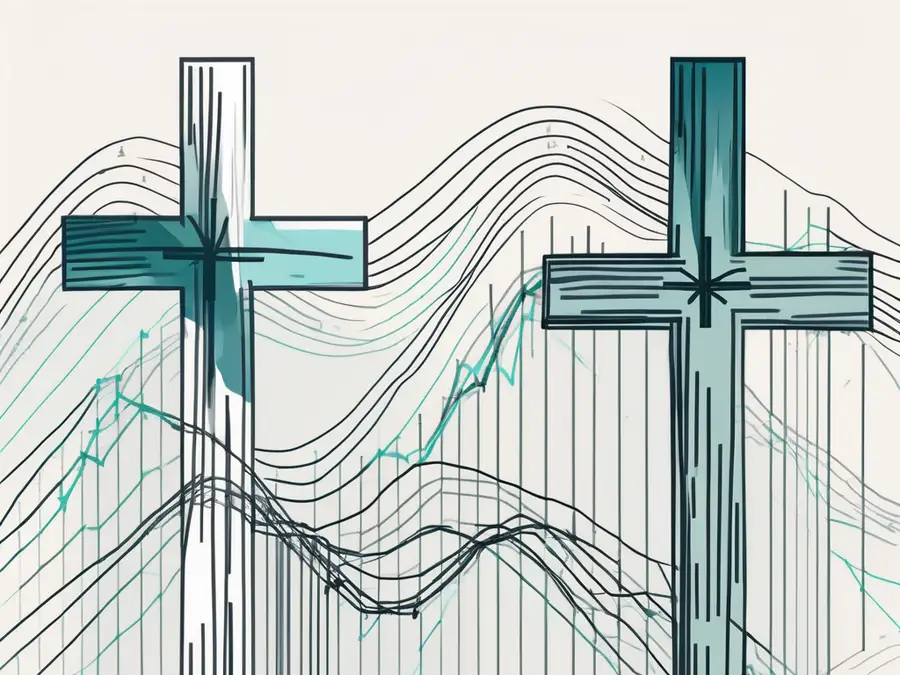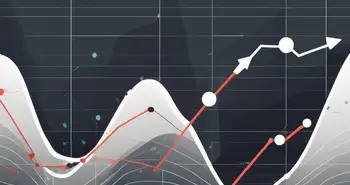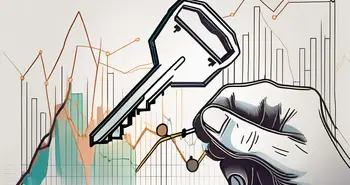Exploring the Death Cross Chart Pattern in Stock Trading

Stock trading can be a thrilling and lucrative venture, but it also comes with its fair share of risks. To navigate the complex world of stock markets, traders often rely on various chart patterns to identify potential trends and make informed decisions. One such pattern that has gained significant attention is the Death Cross.
Understanding the Death Cross Chart Pattern
Before we delve into the intricacies of the Death Cross chart pattern, it is essential to grasp the basics. At its core, the Death Cross is a bearish technical indicator that occurs when the short-term moving average crosses below the long-term moving average. This event signifies a potential shift in market sentiment from bullish to bearish, and traders often interpret it as a strong sell signal.
The Death Cross chart pattern has garnered significant attention among traders and analysts due to its predictive nature in forecasting market trends. This pattern is not to be taken lightly, as it can provide valuable insights into potential price movements and help traders navigate volatile market conditions with more confidence.
The Basics of the Death Cross Chart Pattern
When the Death Cross occurs, it suggests that the stock's price has experienced a significant downturn, and it may continue on a downward trajectory. To identify this pattern, traders typically use two popular moving averages: the 50-day moving average and the 200-day moving average. When the 50-day moving average falls below the 200-day moving average, it triggers the Death Cross.

Traders often monitor the Death Cross closely, as it can serve as a pivotal moment in their trading strategy. The intersection of these moving averages symbolizes a shift in market dynamics, prompting traders to reevaluate their positions and risk management strategies to adapt to the evolving market conditions.
The Significance of the Death Cross in Stock Trading
As traders, it is crucial to understand the significance of the Death Cross and its implications for our trading decisions. The Death Cross acts as a warning sign, indicating a potential downtrend in stock prices. Traders who recognize this pattern can adjust their strategies accordingly, making informed decisions to protect their investments.
Furthermore, the Death Cross is not a standalone indicator but is often used in conjunction with other technical analysis tools to validate trading signals. By combining the insights from the Death Cross with other indicators such as volume analysis or support and resistance levels, traders can enhance the robustness of their trading strategies and improve their overall performance in the market.
The Technical Analysis Behind the Death Cross
Now that we grasp the basics, let's dive into the technical analysis that underpins the Death Cross chart pattern.
The Role of Moving Averages
Moving averages play a crucial role in calculating the Death Cross and providing traders with insights into market trends. The 50-day moving average reflects short-term price movements, while the 200-day moving average considers more long-term trends. When these two averages intersect, it indicates a potential shift in momentum.
Furthermore, the Death Cross is not a standalone signal but is part of a broader spectrum of technical analysis tools used by traders. By combining moving averages with other indicators such as volume analysis, relative strength index (RSI), and support and resistance levels, traders can gain a more comprehensive view of the market dynamics and make informed trading decisions.
Interpreting the Death Cross Signal
Interpreting the Death Cross signal requires a cautious approach. Traders need to consider various factors, such as the stock's recent performance, overall market conditions, and other technical indicators. Additionally, relying solely on the Death Cross signal may lead to false alarms, so it's essential to analyze the broader context before making trading decisions.
It is crucial for traders to exercise risk management strategies and not rely solely on one signal for their trading decisions. The Death Cross should be viewed as a piece of the puzzle rather than a definitive forecast of market movements. By conducting thorough research and utilizing a combination of technical and fundamental analysis, traders can enhance their understanding of market trends and improve their overall trading performance.
To build a solid trading strategy, integrating technical and fundamental analysis is key. Morpher supports this approach with detailed charts powered by TradingView and the cutting-edge Morpher AI. This AI tool, free for all Morpher users, provides real-time market news to keep you updated with the latest developments. Sign up for Morpher today and access the best tools to refine your trading strategy!
The Impact of the Death Cross on Trading Decisions
Now that we understand the technical aspects, let's explore how the Death Cross can impact trading decisions and risk management.
When delving deeper into the implications of the Death Cross on trading decisions, it is essential to consider the psychological aspect that comes into play. The crossover of the short-term moving average below the long-term moving average can trigger panic selling among investors, leading to a further decline in stock prices. This domino effect highlights the importance of not only understanding the technical signals but also being aware of market sentiment and investor behavior.
Risk Management and the Death Cross
Implementing sound risk management strategies is crucial in stock trading, and the Death Cross can provide valuable insights in this regard. By recognizing the pattern early on, traders can set stop-loss orders to limit potential losses or consider reducing their exposure to the stock.
Furthermore, it is worth noting that risk management goes beyond just setting stop-loss orders. Traders can also utilize options strategies to hedge their positions in the event of a Death Cross formation. This proactive approach not only helps in mitigating risks but also opens up opportunities for alternative trading strategies.
Timing Trades with the Death Cross
The Death Cross not only helps traders manage risk but also assists in timing their trades. Traders who incorporate the Death Cross into their analysis may choose to enter short positions or liquidate existing bullish positions, maximizing their profit potential during bearish trends.
Moreover, the timing of trades based on the Death Cross can be further enhanced by combining it with other technical indicators such as the Relative Strength Index (RSI) or Moving Average Convergence Divergence (MACD). This multi-faceted approach provides traders with a more comprehensive view of market conditions, enabling them to make well-informed decisions.
The Death Cross vs. the Golden Cross
Understanding the distinction between the Death Cross and its counterpart, the Golden Cross, is crucial for comprehensively interpreting chart patterns in stock trading.
While the Death Cross signals a potential bearish trend, characterized by the short-term moving average crossing below the long-term moving average, the Golden Cross signifies a bullish sentiment. This bullish indicator occurs when the short-term moving average rises above the long-term moving average.
Traders often use the Death Cross as a warning of potential downward price movement, prompting caution or even selling positions to mitigate losses. Conversely, the Golden Cross is commonly seen as a buying signal, as it suggests the potential for upward price movement. Traders capitalize on the Golden Cross by entering long positions, anticipating price increases.
Both the Death Cross and Golden Cross are significant in technical analysis. The Death Cross typically indicates a shift from a bull market to a bear market, suggesting that selling pressure may increase. It is often associated with market downturns and can prompt traders to reassess their portfolios to protect against anticipated declines.
In contrast, the Golden Cross is associated with the beginning of a bull market. It often follows a period of consolidation or market correction, indicating that bullish momentum is building. This signal encourages traders to increase their exposure to equities, expecting that prices will rise in the near term.
By understanding and utilizing both the Death Cross and the Golden Cross, traders can better navigate market trends and make informed decisions. These indicators, when used in conjunction with other technical and fundamental analysis tools, can enhance trading strategies and improve overall market performance.
Criticisms and Limitations of the Death Cross Pattern
Like any technical analysis tool, the Death Cross also has its share of criticisms and limitations.
False Signals and Market Noise
One of the primary criticisms of the Death Cross is its susceptibility to false signals and market noise. The stock market is highly unpredictable, and relying solely on the Death Cross may lead to unnecessary panic selling or missed opportunities.
The Death Cross in Different Market Conditions
It's vital to consider market conditions when interpreting the Death Cross. In volatile markets or during periods of low trading volume, the Death Cross signal may not hold the same significance. Traders must exercise caution and consider additional indicators when analyzing the Death Cross in different market contexts.
FAQ
What is the Death Cross chart pattern?
The Death Cross is a bearish technical indicator that occurs when the short-term moving average crosses below the long-term moving average. It signifies a potential shift in market sentiment from bullish to bearish.
How do I interpret the Death Cross signal?
Interpreting the Death Cross signal requires considering various factors, such as the stock's recent performance, overall market conditions, and other technical indicators. It is crucial to analyze the broader context before making trading decisions.
What is the difference between the Death Cross and the Golden Cross?
The Death Cross signals a bearish trend, while the Golden Cross represents a bullish sentiment. The Death Cross occurs when the short-term moving average falls below the long-term moving average, and the Golden Cross occurs when the short-term moving average surpasses the long-term moving average.
What are the limitations of the Death Cross pattern?
The Death Cross has limitations, including false signals and susceptibility to market noise. It is also essential to consider different market conditions and use additional indicators for a more comprehensive analysis.
In conclusion, the Death Cross chart pattern is a valuable tool for traders seeking to identify potential downturns in stock prices. By understanding its basics, interpreting the signal, and considering its limitations, traders can incorporate the Death Cross into their overall trading strategies, enhancing their decision-making process and risk management. Remember, successful trading requires a comprehensive approach, considering various indicators and market conditions to maximize your profit potential and minimize risks.
Ready to apply your understanding of the Death Cross and other chart patterns to real-world trading? Discover the innovative world of Morpher, where you can trade stocks, cryptocurrencies, and more with zero fees and infinite liquidity. Embrace the power of blockchain technology and take advantage of features like fractional investing, short selling without interest fees, and up to 10x leverage to amplify your trades. Experience the unique trading platform, Morpher, that's designed for the modern investor.

Disclaimer: All investments involve risk, and the past performance of a security, industry, sector, market, financial product, trading strategy, or individual’s trading does not guarantee future results or returns. Investors are fully responsible for any investment decisions they make. Such decisions should be based solely on an evaluation of their financial circumstances, investment objectives, risk tolerance, and liquidity needs. This post does not constitute investment advice.

Painless trading for everyone
Hundreds of markets all in one place - Apple, Bitcoin, Gold, Watches, NFTs, Sneakers and so much more.

Painless trading for everyone
Hundreds of markets all in one place - Apple, Bitcoin, Gold, Watches, NFTs, Sneakers and so much more.









